Chapter 19. Text 101
Swing provides an extensive collection of classes for
working with text in user interfaces. In fact, because there’s so much
provided for working with text, Swing’s creators placed most of it into
its own package: javax.swing.text
. This package’s dozens of interfaces and classes (plus the
six concrete component classes in javax.swing) provide a rich set of text-based
models and components complex enough to allow endless customization yet
simple to use in the common case.
In this chapter we’ll look at JTextComponent, the base class for all of the
text components shown in Figure
19-1, and then discuss JTextField, JPasswordField, and JTextArea. Then we’ll introduce what’s going on
behind the scenes. We save the more complex model, event, and view classes
for later, but we occasionally refer to things you may want to investigate
further in the next four chapters.

Figure 19-1. A sample of Swing text components
JFormattedTextField is an
extension of JTextField with formatting
and object-parsing abilities. We’ll devote Chapter 20 to JFormattedTextField and its related
classes.
Swing text components allow you to customize certain aspects of the
L&F without much work. This includes the creation of
custom carets (cursors), custom highlighting, and custom key bindings to
associate Actions with special key
combinations. These features are covered in Chapter 21.
We describe ...
Get Java Swing, 2nd Edition now with the O’Reilly learning platform.
O’Reilly members experience books, live events, courses curated by job role, and more from O’Reilly and nearly 200 top publishers.

